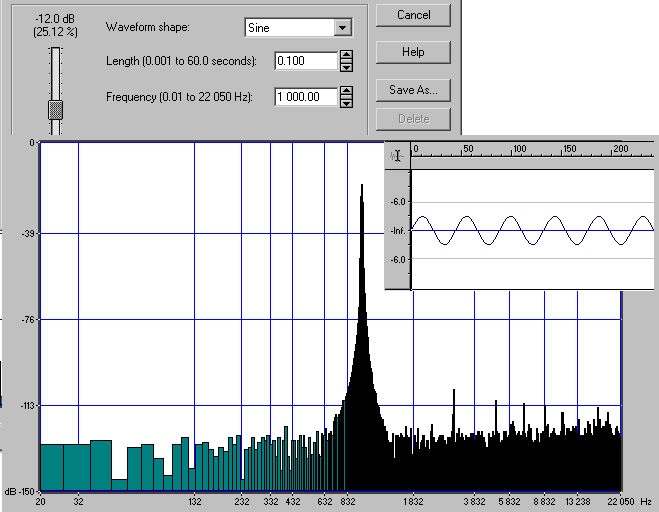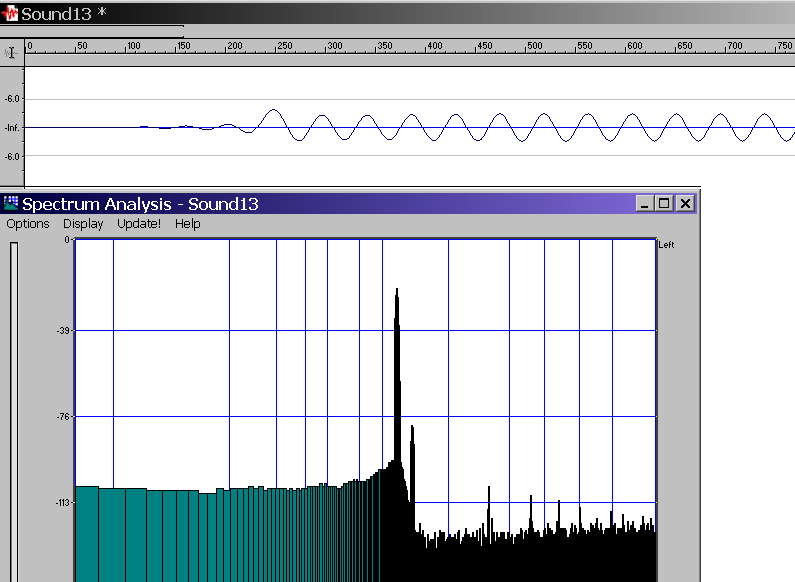Hello, Jazz. I've begun my experiments with sinewaves and filters.
Here's the first part, which deal with amplitude modulation. The second part will adress time smearing.
Amplitude modulation can be produced adding two close frequencies f1 and f2. The result is a sinewave of frequency (f1+f2)/2 modulated by a so-called "beating" of frequency f2-f1.
Let's generate a 1000 Hz sinewave :
Its spectrum is one single peak at 1000 Hz.
The same for a 1200 Hz sinewave :
Now, if we mix them together, the result is an amplitude modulated sinewave :
However, if we perform the spectrum analysis of the modulated sine, we can still see the two original frequencies :
This is very important to understand : a modulated sinewave is nothing more than two close frequencies. There is absolutely nothing below that accounts for the modulation.
In a spectral decomposition, the fundamental frequency would indeed be very low, since the wave repeats itself only after many oscillations. In our case, it would be 200 Hz, with harmonics at 400, 600, 800 etc.
It is interesting to list the complete decomposition with their relative amplitudes :
Frequency / level
200 Hz / 0
400 Hz / 0
600 Hz / 0
800 Hz / 0
1000 Hz / 1
1200 Hz / 1
1400 Hz / 0
1600 Hz / 0
All other harmonics : 0
The mystery of the missing low frequencies is now clear : the fundamental is there, but with a strictly null amplitude, and every harmonic has a null amplitude except the 4th and 5th ones, that are 1000 and 1200 Hz.
Now, what happens if we filter this modulated wave ? Let's use SoundForge parametric equalizer with the 1000-1200 Hz lowpass, with -60 dB at 1200 Hz (it can't do less).
With the RMAA software, I've plotted the frequency response of the filter :
Frequencies of 1000 Hz and below are not attenuated. Frequencies above 1200 Hz are reduced by a factor of -60 dB.
Here is the result :
There is a strange side effect at the beginning, with smearing, then the wave goes on without modulation.
The spectrum shows that the 1200 Hz peak have indeed been reduced by 60 dB. Since the only significant frequency left is 1000 Hz, we get back the sine, unmodulated.
Last, let's just have a look at a native amplitude modulated sine. I start again from the 1000 Hz sine, but instead of adding another frequency, I directly ask for amplitude modulation in the software filters :
This way, my sine will be multiplied by a 100 Hz sine. Let's see the result and its spectrum :
Amplitude modulation is there, and this time, we have not two, but three peaks on the spectrum analysis. I don't know exactly why. But we can see that there is still no low frequency at all.
Now let's see the first part of your arguments :
Quote:
Originally Posted by JaZZ /img/forum/go_quote.gif
...which shows the preserved amplitude modulation even after proper (although unusually smooth) low-pass filtering with a cut-off frequency around 20/21 kHz.
|
"Preservation" is not the right word here, since the diagram reads "Response 20 kHz sinus". Amplitude modulation is therefore an artifact in this example. It shows that the original 20 kHz sine comes together with other near frequencies. That's not surprising since we are playing with anti-alias filters. The frequency in question is certainly the alias of the sine, which is 22050 + (22050 - 20000) = 24100 Hz.
Together, the original 20000 Hz sine and the parasite 24100 Hz one produce the modulation. This is common with very simple filters. The frequency response of the filter drops to zero at exactly 22050 Hz, but goes up again above 22050 Hz, which allows for the 24100 Hz alias to be there ! Like in this diagram,
Which is the frequency response of a "zero-order hold" filter (i.e. the bare output of a DAC with no filter).
Quote:
Originally Posted by JaZZ /img/forum/go_quote.gif
Since there are no frequencies above 22 kHz left, it's not aliasing in the classic sense. You're free to call it like this, but it's not caused by «forbidden» frequencies.
|
The simple fact that the sine is modulated shows that the response of the filter is not finished at 22050 Hz, and that there are further lobes beyond the diagram.
Unless you mean that there is another frequency
below 22050 Hz that causes the modulation. But I fail to see how it could have been introduced, since the original is a pure 20 kHz sine.
The "sampling" at 44100 Hz only introduces new frequencies above 22050 Hz, not below (except noise). (Actually, it's the D/A conversion that introduces them).
Quote:
Originally Posted by JaZZ /img/forum/go_quote.gif
A «proper» filter in your sense is one with a massive filter resonance -- that would indeed do the trick.
|
Not necessarily. If your filter had no further lobes, it would just destroy the 24100 Hz alias, and attenuate slightly some frequencies below 22000 Hz. Think about the effect on the spectrums above. We would just get a slighty attenuated 20 kHz sine with very little smearing, and no modulation at all.
Quote:
Originally Posted by JaZZ /img/forum/go_quote.gif
Since you call it «smooth», it doesn't seem to be similar to a classic antialiasing filter which calls for ultimate sharpness. It's absolutely possible to create an unobtrusive low-pass filter, as MP3 encoders and the like show.
|
That's exactly the kind of filters used for anti-aliasing. They are called "brickwall" in comparison with Butterworth filters, that are usualy very soft, like 6 dB per octave, for example, while we need here minus infinite within a fraction of octave.
But they are smooth in comparison with real sinc filters.
For example, here is the frequency response of my Yamaha CD player (model CDX-860, 450 euros in 1991) :
That's sharper than a speaker filter, but far from a "sinc" brickwall, that would be a vertical line.
Quote:
Originally Posted by JaZZ /img/forum/go_quote.gif
So your orange world view dictates you that my listening impressions aren't trustworthy beforehand -- and the filter variants are there to fool the customers...
|
You have perfectly stated your position on that matter : you are not interested in blind testing. I have no problem with it, but am myself only interested in blind testing. So I'll just deal with the technical side of the discussion























.gif)
